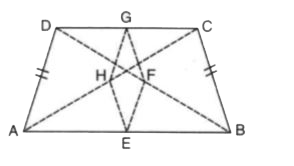Let ABCD be a quadrilateral with ∠CBD=2∠ADB,∠ABD=2∠CDB,AB=BC, then
AD=CD
∠ADB=∠CDB
∠CBD=∠ABD
∠ADC is2π3
The correct Answer is:A, B, C
2x=∠CBD
2y=∠ABD
In △CBD
sin(π−(2y+x))sinx=BDBA=BDBC=sin(π−(2x+y))siny
⇒sin(2+x)siny=sin(2x+y)sinx
=12[cos(y+x)−cos(3y+x)]=12[cos(x+y)−cos(3x+y)]
0<x+y=12ABC<π2
0<(3y+x)+(3x+y)<2π
=∴3y+x=3x+y⇒x=y
⇒∠ABD=∠CBD⇒AD=CD

Similar Questions
ABCD is a quadrilateral. Is AB+BC+CD+DA>AC+BD?
View SolutionLet ABCD be a cyclic quadrilateral such that AB=2,BC=3,∠B=120∘ and area of quadrilateral =4√3. Which of the following is/are correct ?
View SolutionABCD is quadrilateral. Is AB+BC+CD+DA<2(AC+BD)?
View SolutionABCD is a quadrilateral in which AB=BC and AD=CD ,Show that BD bisects both the ∠ABC and ∠ADC.
View SolutionLet ABCD be a quadrilateral in which AB is parallel to CD and perpendicular to AD, AB = 3CDand the area of the quadrilateral is 4 square units. If a circle can be drawn touching all the sides of the quadrilateral, then its radius is:
View SolutionIn a quadrilateral ABCD, −−→AB+−−→DC=
View SolutionIf ABCD is a cyclic quadrilateral, then prove that AC.BD=AB.CD+BC.AD
View SolutionConstruct a quadrilateral ABCD with AB=3 cm, AB=3cm, AD=2.7 cm, DB=3.6 cm, ∠B=110∘ and BC=4.2 cm. Construct another quadrilateral A'BC'D' similar to quadrilateral ABCD so that diagonal BD'=4.8 cm.
View SolutionABCD is a quadrilateral in which AB||DC and AD = BC. Prove that ∠A=∠Band∠C=∠D.
View SolutionABCD is a quadrilateral in which AD = BC. E, F, G and H are the mid-points of AB, BD, CD and AC respectively. Prove that EFGH is a rhombus.

View Solution